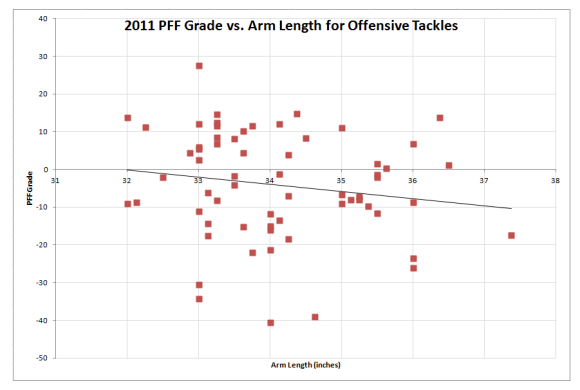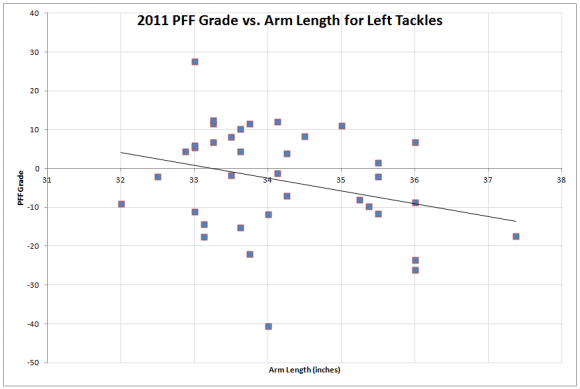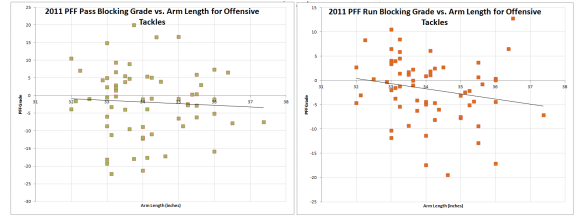As you may have read over the past few weeks since the draft, Lions 1st round pick Riley Reiff may have been a steal in the first round…or his stubby arms will prevent him from playing effectively at left tackle in the pros. Last week, Pro Football Weekly released a video discussing the pick.
While much has been made of his arms being “short,” not allowing him to keep defensive ends at bay as effectively, I’ve been wondering how a guy’s arms can go from being short at 33-1/4″ to being long at 34″ (See the cbssports.com scouting report of Jammal Brown, calling him a “long-limbed athlete”). While we can quibble over the difference that 3/4″ of arm makes, does arm length really matter that much in success as an NFL offensive tackle? One profootballfocus.com subscription and about 4 hours of scouring the internet later, I have the data at my disposal to answer that question (statistically speaking, anyway).
For those that don’t know about PFF, they watch every snap of every game and grade players according to their performance. Basically, they have all the statistics I always wished I had when I was writing game reviews last year. So taking the 2011 grades for every offensive tackle in football with over 300 snaps last year, and filling in the blanks of arm length (apparently this is much harder to find than I could have imagined when I came up with this idea), I made the following graph of PFF grade vs arm length.
Imagine my surprise when there was actually a negative slope on the curve fit to this data. I will say that this data is from 1 season only, and the correlation is pretty weak. But at best, this shows that having longer arms is a disadvantage and at worst it shows that there’s basically no correlation between arm length and success at tackle. Another interesting thing that you’ll note is that the majority of tackles in the NFL have arms between 33 and 34 inches, particularly among those with positive grades. So not only are “short” arms not a disadvantage, but they’re also not uncommon. A good counter argument that you might make is that including right tackles might bias the data. Many of the scouting reports I read claimed that Reiff may have to move to right tackle because of his arm deficiency. So maybe the short-armed right tackles are having success against the lesser pass rushers on the right side of the line. Okay, fair enough. PFF also lists whether these guys played left or right tackle, so I present you with exhibit 2, a chart showing only the left tackles.
This graph shows the same trend, even more convincingly. I can even break it down between pass block and run block grades.
Still, no dice. Any way you slice it, there’s nothing in these stats that indicates that longer arms are better for an offensive tackle. I for one, am glad Reiff’s short arms allowed him to fall to the bottom of the 1st round.



awesome work! when do you plan on running this for the past decade? :7) (j/k)
Thanks for reading, rhoneyman!
Believe me, I would have loved to have a bigger sample size. The first problem with that is that no one actually keeps arm length data that I can find. What I have is patchwork from draft scouting reports and sparse combine results. Since those inevitably fade to the back corners of the internet after a few years, it’s already biased towards the younger guys. If I were to add in previous years, I’d only really have arm length data for the youngest guys and I’d just end up with repeats on a small number of players. The other problem is that PFF data only goes back to 2008, so even if I wanted a 10 year sample, I’m limited.
-Nate